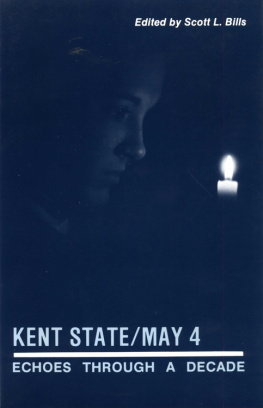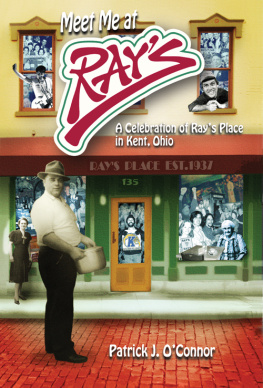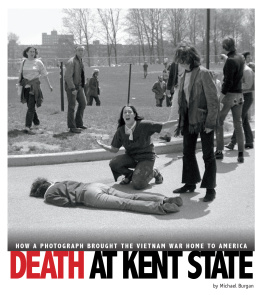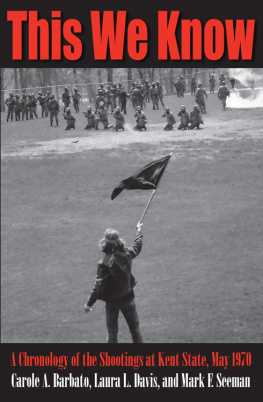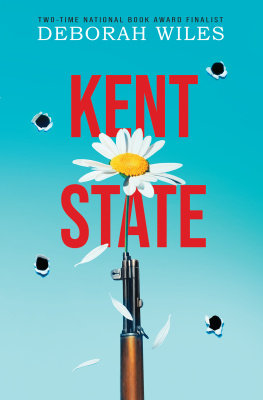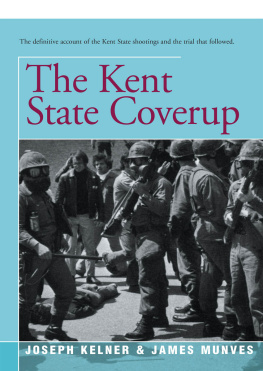
Kent State/May 4
KENT STATE/MAY 4
ECHOES THROUGH A DECADE
Edited by Scott L. Bills
THE KENT STATE UNIVERSITY PRESS
Kent, Ohio, and London, England
1982, 1988 by The Kent State University Press, Kent, Ohio 44242
All rights reserved
Library of Congress Catalog Card Number 87-31685
ISBN 0-87338-278-1
ISBN 0-87338-360-5 pbk.
Manufactured in the United States of America
Articles which previously appeared in whole or in part in the journal
Left Review are used with permission.
Photo on p. 17 courtesy of John A. Darnell, Jr., 1970.
08 07 06 05 6 5 4
Library of Congress Cataloging-in-Publication Data
Kent State/May 4 : echoes through a decade / edited by Scott L. Bills.
p. cm.
Bibliography: p.
Includes index.
ISBN 0-87338-360-5 (pbk. : alk. paper)
1. Kent State UniversityRiot, May 4, 1970. 2. Kent State UniversityStudentsAttitudes. I. Bills, Scott L.
LD4191.072K45 1988
| 378.771'37dc19 | 87-31685 |
| CIP |
British Library Cataloging-in-Publication data are available.
for
J. L.
19401980
Contents
AT KENT STATE UNIVERSITY TODAY FOUR PERSONS WERE KILLED AND OTHERS INJURED IN A CONFRONTATION BETWEEN OHIO NATIONAL GUARD TROOPS AND A MOB OF UNIDENTIFIED PERSONS, telegraphed Ohio Governor James Rhodes to J. Edgar Hoover, director of the Federal Bureau of Investigation. TELL ME FATHER DID THEY AIM? asked a telegram from singer Mary Travers. A firestorm of protest and indignation flared across the landscape of American higher education. There was fear and anxious anticipation. Army and National Guard units were on hand in Washington at weeks end as a great crowd of youths gathered for an antiwar demonstration on Saturday, May 9. A moatlike ring of 59 city buses, parked bumper to bumper along Executive Avenue, separated the protesters from the White House and President Nixon , reported the New York Times. Max Frankel wrote on Sunday, May 10: America was a nation in anguish last week, her population divided, her campuses closed, her capital confused, her President perplexed. The lines of conflict ran zigzag across the land. The domestic upheaval in response to expansion of the U.S. war in Southeast Asia and the deaths at Kent State, observed Frankel, sent tremors of fear through the White House that revolt and repression might be nearer than anyone had dared to imagine. One Kent State student was quoted as saying, Whats the use? I feel, what can we do? What kind of democracy is this?
Zigzag lines of conflict was the persistent theme of May 4-related controversies during the ensuing years, as discussed in this book: sparring and countersparring in the courts, through the hearts and minds of several generations, over and around the grassy hillside in the center of the Kent State campus. What has changed? Whereas the terms of reference in the May 4 debate formerly and typically expressed anger and exuded polemic, the sentiments most frequently voiced since 1985 have been those of reconciliation and healing. It is not an inconsequential change. In the midst of familiar props from the past years of contention, there has emerged a shared desire for an commitment to a permanent memorial, near where the shots were fired, to the death and disruption of May 1970.
This paperback reprinting of Kent State / May 4: Echoes Through a Decade retains the same title, though we are now nearly two decades distant from the spring of 1970. The book is unchanged except for an addendum to the annotated bibliography and this preface, which serves as an update to the introduction, The Past in the Present, primarily with regard to the discussion of, planning for, and selection of a new memorial. Referents to May 4 already dot the campus, as indicated in the introduction: sculptures, a granite marker, the activities of the Center for Peaceful Change, a resource room in the library, a major archival collection, and a brief statement in University catalogs. But this assemblage represents years of increments sponsored by numerous individuals and organizations, spawned by differing issues and viewpoints, rather than a single, uniform impulse toward reflection and remembrance. Hence, with plans for a permanent memorial, there is a consensus at least on the issue of historical significance; and there is a new dimension to the life of the past in the presentone which is in part the product of a new willingness to embrace ambiguity and pain in the course of marking epochal events and movements.
A New May 4 Memorial
In December 1983, prompted by a proposal from the May 4th Task Force and acting with the encouragement of University President Michael Schwartz, the Kent State Board of Trustees took the first step toward an officially sanctioned physical memorial to the May 4 shootings. The Trustees authorized the establishment of a special committee, to be appointed by Schwartz, charged with assessing Meeting for the first time in latter March 1984, the ten members of the May 4th Memorial Committee represented students, faculty, administrators, and alumni of the University as well as community interests. The committees report and recommendations were made available in December 1984.
In a brief survey of the significance of the May 4 shootings, the committee concluded that after fifteen years the Kent State shootings remained a visible milestone in a war that belongs to another generation. As such, the events of May 1970 had a measurable impact on national politics as well as a profound influence on the course of Kent State University. In pointing to a positive as well as a negative legacy for the institution, the report stated: The annual memorial activities, the work of dedicated students and faculty, suggest the meaning May 4th will have for the future at the University. It is that a place of learning cannot escape the outside world, but can mobilize its resources to work toward a better, more equitable, and above all, a more peaceful society. Surveying the existing memorials on campus, the committee noted that they do not choose sides. All society was the victim on May 4thstudents, Guardsmen, townspeople, and faculty. The four dead paid the ultimate price. The committee concluded that the Kent State shootings were of such significance that a permanent memorial was appropriate and necessary, that May 4 sensitized America to regimented lines of communications and authority. May 4th changed forever how future demonstrationspeaceful and otherwisemust be perceived, analyzed, understood, and settled non-violently. Yet, the committee noted that even so many years after the shootings, there was still no single accepted explanation for why the shootings had occurred; further, it was apparent that the many constituencies at Kent State University and in the community in early May of 1970 had multiple and often conflicting purposes for their activities. That is, many different viewpoints had been represented by the people who gathered on the Commons and observed events from off campus in the spring of 1970.
Therefore, the Committee believes that in order to memorialize these events effectively, a site which reflects the diverse constituencies and meanings would be most appropriate. This reflective site should present the visitor with the opportunity to inquire into the many reasons and purposes of the events that led to the killing and wounding of students on May 4, 1970 and to encourage a

